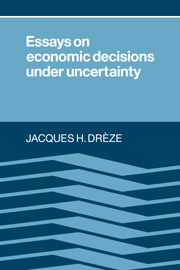Book contents
- Frontmatter
- Contents
- Acknowledgements
- Foreword
- I Decision-making under uncertainty: general theory
- II Markets and prices
- III Consumer decisions
- IV Producer decisions
- V Theory of the firm
- IV Human capital and labour contracts
- VII Public decisions
- 19 Pricing, spending and gambling rules for non-profit organisations
- 20 Econometrics and decision theory
- Index
19 - Pricing, spending and gambling rules for non-profit organisations
Published online by Cambridge University Press: 01 October 2009
- Frontmatter
- Contents
- Acknowledgements
- Foreword
- I Decision-making under uncertainty: general theory
- II Markets and prices
- III Consumer decisions
- IV Producer decisions
- V Theory of the firm
- IV Human capital and labour contracts
- VII Public decisions
- 19 Pricing, spending and gambling rules for non-profit organisations
- 20 Econometrics and decision theory
- Index
Summary
Introduction and conclusions
Questions
During our association with universities in Europe and in the United States, we have encountered many questions apt to challenge economists, for instance:
Should prices charged in university hospitals reflect (marginal) costs alone, or include a monopolistic markup?
Should faculty salaries be determined by a standard scale, or vary with the alternative opportunities of faculty members? (For instance, should the respective salaries of a medical doctor and of a biologist, doing similar work in a research laboratory, reflect the higher opportunity cost of the medical doctor?)
How should a university allocate its resources among alternative uses, like education and research?
Should universities enjoying an endowment fund aim at spending income and maintaining capital, or at accumulating part of the income, or at depleting the fund at some optimal rate?
What rate of discount should be used by a university for decisions about plant and equipment?
What should be the attitude of a university toward portfolio risk? Should universities adopt less conservative investment policies than, say, managers of private trust funds? (This was once intimated by officers of a Foundation Oriented toward Research and Development; that foundation has recently reduced its spending, due to a sharp decline in market value of endowment.)
All these questions arise because universities operate under a budget constraint, the level of which is not always set optimally; produce public goods (research); and are sometimes required to sell services below cost (education in state universities).
- Type
- Chapter
- Information
- Essays on Economic Decisions under Uncertainty , pp. 385 - 400Publisher: Cambridge University PressPrint publication year: 1987

